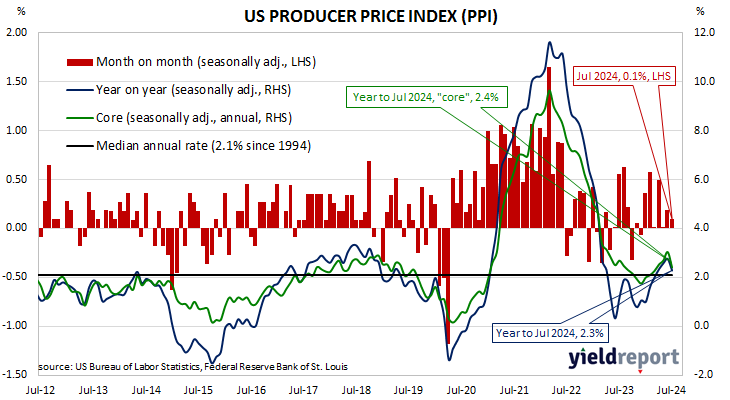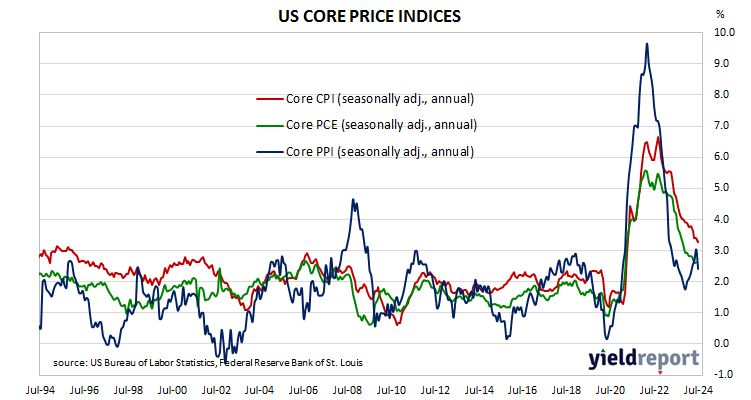Summary: US producer price index (PPI) up 0.1% in July, below expected increase; annual rate slows to 2.3%; “core” PPI flat over month, up 2.4% over year; Citigroup: suggests muted inflationary pressures; US Treasury yields fall; rate-cut expectations harden; Westpac: consistent with benign July PCE reading; goods prices up 0.6%, services prices down 0.2%.
Around the end of 2018, the annual inflation rate of the US producer price index (PPI) began a downtrend which continued through 2019. Months in which producer prices increased suggested the trend may have been coming to an end, only for it to continue, culminating in a plunge in April 2020. Figures returned to “normal” towards the end of that year but then moved well above the long-term average in 2021 and 2022 before falling back over 2023.
The latest figures published by the Bureau of Labor Statistics indicate producer prices increased by 0.1% in July after seasonal adjustments. The result was below the 0.2% increase which had been generally expected as well as June’s 0.2%. On a 12-month basis, the rate of producer price inflation after seasonal adjustments slowed from 2.7% to 2.3%.
Producer prices excluding foods and energy, or “core” PPI, remained unchanged after rounding and seasonal adjustments. The result was less than the 0.2% increase which had been generally expected as well as June’s 0.3% rise. The annual growth rate slowed noticeably, from 3.1% after revisions to 2.4%.
“While core PPI was modestly stronger in July and revised higher in June, softer headline and mixed details still suggest overall muted inflationary pressures,” said Citigroup senior economist Veronica Clark. “We expect this trend of easing inflation will be reaffirmed in July CPI data tomorrow.”
Short-term US Treasury bond yields fell noticeably while longer-term yields fell more moderately on the day. By the close of business, the 2-year Treasury yield had shed 9bps to 3.93%, the 10-year had lost 6bps to 3.84% while the 30-year yield finished 4bps lower at 4.16%.
In terms of US Fed policy, expectations of a lower federal funds rate in the next 12 months hardened, with around eight 25bp cuts currently factored in. At the close of business, contracts implied the effective federal funds rate would average 5.155% in September, 4.66% in November and 4.46% in December. July 2025 contracts implied 3.37%, 196bps less than the current rate.
“Components of the PPI that feed into the Personal Consumption Expenditure (PCE) inflation gauge were consistent with a benign reading for July,” said Westpac economist Jameson Coombs.
The BLS stated the fall of the index was attributable to a 0.6% increase in good prices. The final demand services index fell by 0.2%.
The producer price index is a measure of prices received by producers for domestically produced goods, services and construction. It is put together in a fashion similar to the consumer price index (CPI) except it measures prices received from the producer’s perspective rather than from the perspective of a retailer or a consumer. It is another one of the various measures of inflation tracked by the US Fed, along with core personal consumption expenditure (PCE) price data.



